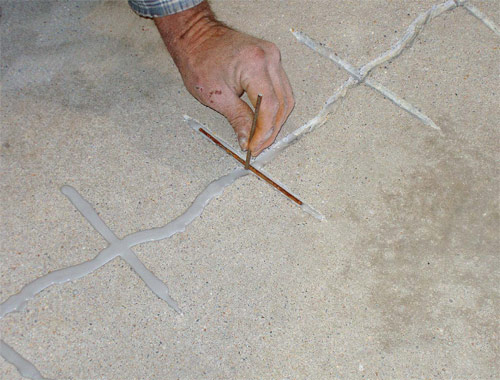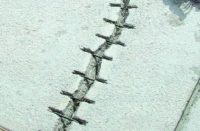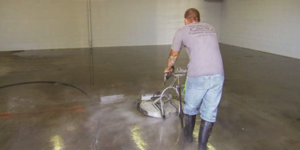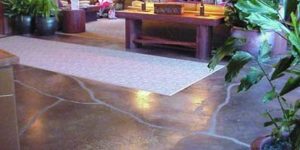
There’s at least one thing all concrete installers agree on: Concrete cracks. They differ, however, on how to approach repairing those cracks.
The American Concrete Institute report “Causes, Evaluation, and Repair of Cracks in Concrete Structures,” prepared by ACI Committee 224, lists a dozen different ways to repair cracks, so it’s no surprise that installers use different methods and approaches. According to the report, “cracks need to be repaired if they reduce the strength, stiffness, or durability of the structure to an unacceptable level, or if the function of the structure is seriously impaired… In addition, repairs that improve the appearance of the surface of a concrete structure may be desired.”
Cracks often appear because not enough joints have been cut in the concrete, notes Scott Metzger of Metzger/McGuire. “Once the crack has been induced, you already have a plane of weakness.”
Getting started

So when it comes to crack repair, where to start? John Heidmann, general sales manager for Concrete Polishing Solutions, says the first thing to do is clean the crack. “You use a crack-chaser blade, which is specifically designed to even the crack out to a specific depth,” he explains.
“This will allow you to have a clean, even edge on either side of the crack and then come back and fill it with a joint filler.” Use a semirigid material to fill the crack because it has some flexibility to it, he says.
You should establish why the crack needs repair, says Chris Sullivan, vice president of sales and marketing with ChemSystems Inc. “Is this an aesthetic repair, where the repair needs to look as good as possible, or is it is a repair that’s going to be covered by something, like an overlay? That will determine what materials you use, how careful you need to be, and what it needs to look like.”
Determine the crack type
Also, you should review cracks to determine whether they are plastic shrinkage cracks, structural cracks or settlement cracks before considering any repair technique. Because most repairs aren’t aesthetic and most crack repair is done on floors, Sullivan prefers what is known as bridging or knitting a crack.
“You fill the crack and then put some kind of bridge across the surface so it’s convex,” he explains. “You take the impression out so whatever you put on the surface doesn’t (settle) into the opening.”

Methods to repair cracks
Bob Harris of the Decorative Concrete Institute uses crack stitching. “We take a 4-inch diamond grinder,” he says. “And we’ll chase the crack for depth, following the contour of the crack.” Then they make perpendicular cuts across the crack, and embed block ladder wire into those cuts. Next, they overfill the crack and, when dry, they grind it back flush. “It looks like Frankenstein’s monster,” Harris admits.
One of the more popular ways to fix structural cracks is with crack injection. To do this, drill holes into the crack at intervals that equal the thickness of the slab. Then, inject epoxy into the first hole until it overflows out of the second one, and so on, Harris says.
A specialized repair product like Roadware 10-Minute Concrete Mender is another option for crack repair. “We put Mender into the crack and it has an attraction to the rock,” explains Richard King, vice president of sales and distribution for Roadware Inc.
“It’s thin enough to get into the concrete and it pulls to the aggregate.” Sandblast sand and Concrete Mender in a crack combine to create “polymer concrete,” in which a polymer does the work of portland cement. “Once it cures, it will never get harder than the original slab,” King adds.
Repairing static cracks in stamped concrete or countertops is much more difficult, says Sullivan. “You’re blending color and texture. And there’s a limited number of materials that are going to allow you to create something that’s exactly the same or to blend in,” he says.
“You can use colored caulks or grouts, but trying to blend those in can make it look worse. I tell people that it is sometimes better to make it a contrasting color. Make it look like the crack is there for a reason.”
Making do
Sometimes not fixing a crack is okay, says Harris. “You can make it part of the design,” he says. “We do that often by doing things like staining it a different color or saw-cutting leaves on the other side of it to make it look like a vine. Every situation is different.”
When should you repair a crack? Sullivan suggests repairs in the following circumstances:
- The crack has become a safety hazard.
- The crack compromises the concrete’s performance.
- The appearance of the crack takes away from the look of the concrete.
According to Harris, a moving or working crack that’s more than the width of a credit card or a crack that has elevation needs repairing. Also, if the crack could cause an unhygienic situation, as a crack in a countertop or on a kitchen floor might, a repair should happen to prevent bacterial growth.
“But if it is a tiny, paper-thin crack and is static, I’d leave it,” says Sullivan.

Photo courtesy of Bob Harris
Learn to deal with cracks
Rarely is replacing the slab preferable to fixing the crack. The cost of replacement can be prohibitive, costing up to five times as much as the original slab. “There are repair materials to address just about any situation,” says Heidmann, “so I don’t know if the crack itself will dictate busting up and replacing the slab. I think it comes to down to whether you plan to polish as a final flooring or if something is going on top of it.”
Although concrete experts understand that cracks will happen, their customers aren’t always so knowledgeable. In fact, Metzger says, most customers view cracks as a flaw. Therefore, managing customer expectations is very important, the experts agree. Consequently, it’s vital to have good communication from the very beginning of project discussions.
“It’s very important not to overpromise,” says Heidmann. “Concrete turns gray. It gets hard. It cracks. And there is no way to guarantee that it won’t crack. You have to be upfront that it will happen, and that any kind of repair will likely stand out.”

Questions from Readers
Question
What product would be best for in-floor heat concrete floor repair?
Answer from Concrete Decor
I believe the best solution for that type of random crack is a joint sealant. Joint sealant has some flexibility but will also be flat with the existing surface. Solid Solutions in Southern California has a sealant that can also closely match the existing color of your floor. The product is available in a bottle (Part A) along with a color pack (Part B) that you add to the bottle when you’re ready to install.
The bottle has a tip on it that you can cut to the appropriate size of your crack. You just squeeze the bottle and fill the joint. You will want the materials to over-fill the joint slightly so that when it cures you can come back and cut the excess off with a razor blade. If you’re familiar with the small razor blades people use to clean glass, they also come with a small 3-inch-long handle. That should do the trick.
I recommend this product. Once you order the material I can help to ensure that what you receive from the manufacturer most closely matches your existing floor. They may also have some additional tips for coloring that I can share with you, if available.
This product shouldn’t have an adverse effect from the radiant heating elements already in your floor. I’m assuming this is an interior surface, correct?















